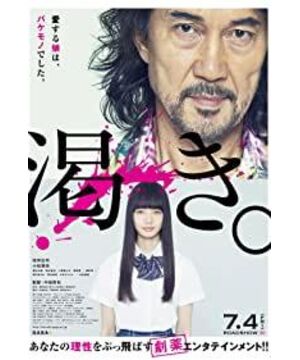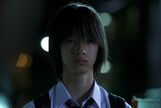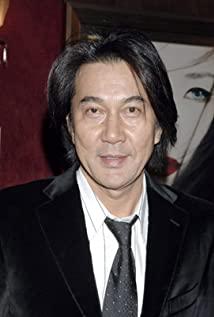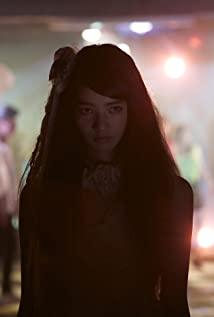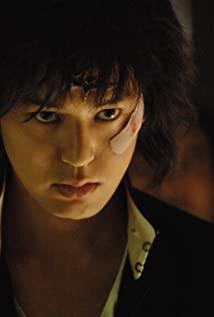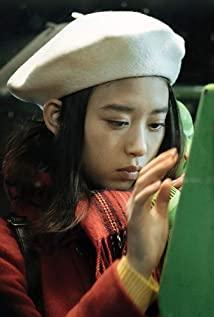Let’s talk about “postmodern” first. Textbooks define "postmodern cinema" as follows: abnormal plot structure, comic-like narrative tone, hybrid collage, TV commercial-like aesthetic language, violent poetics of black humor, irony and parody. . Thinking back to this movie, it really has a typical postmodern character. The father, played by Koji Yakusho, used to be a policeman, but was later derailed by his wife and became insane. Whenever he was in a trance state, the picture would cut to several shots of a happy family: a beautiful wife and a naive wife who prepared meals at home and waited for her husband to come home. Lovely daughter, it turned out to be a TV commercial. This advertisement is what he can see on TV every day, contrary to his real broken family situation, it is exactly what he desires most - a happy and healthy family. In addition, the film is extremely bloody and violent. Despite this, the picture still uses the cut-in comic-style blood on the ground to ease the blood that should have been there, and with funny voices, such as the "poof" after being beaten. Voice. MTV's paragraph insertion is also a feature of postmodern cinema. The teenager entered Kanako's party, crazy, drugs, nudity, exaggerated make-up and costumes, all of which were fragmented and combined by flashing cameras and exciting music, but they seemed so reasonable. This paragraph is also one of my favorite passages. There is a feel in skins~ On the contrary, Tetsuya Nakajima is still playing this kind of cool pioneer thing when he is old. It's amazing that we young people can't tolerate it. There can be Japanese-style movies like Ozu's peaceful and beautiful respect, or there can be avant-garde post-modern movies like Tetsuya Onakajima Sonoko. Komatsu Nana said that the director is not fierce at all, but like a gentle bear. South Korea's Park Chan-wook thought that the director was a rude job that was not suitable for a literati like him. But the movies they made were completely different from their personalities, which is a wonderful phenomenon. So what if I have the opportunity to make a movie in the future? (holding his cheeks in a contemplative state~)
Second, let's talk about its bloody violence. Tetsuya Nakajima said that he himself did not expect anyone to invest in this film (something called gaga), and he originally planned to produce it independently. The previous confessions were all produced by Toho (a major Japanese production company). Therefore, after leaving the big production company, he has more creative space, and he does not need to consider the box office, and also does not need to consider whether the audience can accept it. This time Nakajima is comparable to Sonoko Wen (a Japanese director who makes violent and eccentric independent films). The castration and incest shown in many of Kim Ki-duk's films have expressed incompetence. This time, Nakajima is also the same thing. He surpassed the boundaries of what the audience can accept, that is, he abandoned part of the audience. In fact, the kind of violence he shows in this film can be regarded as an associative extension of other violent films. For example, in the scene where Odakiri asked and Koji Koji, the father inserted the knife into the killer's abdomen. This kind of plot often appears in other movies, but if it's not desire, then this knife is just enough. When I was watching a movie, I couldn't help but think, will the knife inserted into the human body penetrate deeper or slide left and right? No other movie answered my question, but eagerly said: Yes, look at how I cut Uncle Rang's abdomen, from the bottom to the top. Ah~ so bloody, it hurts to think about it. Also, the sloppy shoulder boy who always wanted to be like Ogata entered the yellow-haired girl Nikaidou's house and cut off her ears. Ordinary movies will have similar cuts of ears and fingers, but it doesn't It will show you the frontal shot of the cut, and will use the screams of the cut to evoke the audience's association with the scene of the cut. Desire but not, I will show it to you, and it is very realistic, which increases the psychological burden of the viewer, from thinking about it to seeing it really hurts.
Finally, the title of this article: To be unique is the most basic desire of human nature. This "uniqueness" can be interpreted as: rare in the world, what everyone pursues, and high above. Kanako in the film is one such character. What the boy said: I like you, but you ruined me. What Hashimoto Ai's friend Nagano-chan expressed, Kanako is so beautiful, she is so unique, I like her so much, and I want to be her. Even Erkaitang said: Why does everyone like her so much? This movie is not about expressing how people like Kanako are, but focusing on the people who are attached to Kanako. There are only two types of people in this world, one is brilliant, and the other is like a mustard (like the boy in the film, he doesn't even have a name). The latter spent his entire life chasing the former, and Nagano lost himself and was destroyed by this pursuit. If the young man can't get what he is chasing, he hopes to destroy her, and he also destroys himself. Just like "Frank", it is not about the genius of Frank, but the bitterness of a little guy like Jon. Geniuses are born geniuses, and ordinary people die in mediocrity. The cruelty is not to have this desire, but to discover the truth behind it. I think the reason why I feel this way is because I feel like a boy in the film, and there is someone like Kanako around me. I can't turn a blind eye to Kanako, but I'm afraid of having a desire - a desire to be unique.
Therefore, the title of this film, "Desire", seems to be off topic, but it is the most appropriate. This longing represents an ambivalence: grab what you can't get, but if you can't get it, it will destroy him. The line between the teenager and his father never intersected, but neither of them got what they wanted. One was destroyed and the other was never obtained.
View more about The World of Kanako reviews


